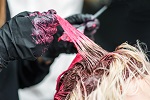
When I stop to think about the women in my life, I realize most of them use hair dye. In fact, one out of three women over eighteen dye their hair but they should know a large study bolsters the link between permanent hair dye and breast cancer. The study also associates breast cancer risk and chemical relaxers which are hair straighteners. The link is especially high for black women who used hair dye. They had a forty-five percent higher risk while white women had a seven percent higher risk.
The study enrolled forty-six thousand women aged thirty-five to seventy-four who had sisters with breast cancer. Eight years later, nearly twenty-eight hundred women developed breast cancer. Fifty five percent of them used permanent hair dye.
Black women had the highest risk, but women who used straighteners or personally applied dyes or straighteners also had higher risks. Women who used straighteners in the twelve months before the study had a nearly twenty percent increase in cancer risk. It rose to thirty-one percent when they used straighteners at least every five to eight weeks regardless of race.
You could argue the results aren't surprising since hair dyes contain more than five thousand chemicals including known mutagens or have hormone disrupting properties.
Mutagens cause changes in cellular DNA which can increase cancer risk. One in eight American women will develop breast cancer in her lifetime, but that number could go down if a safer hair dye becomes available.
More Information
Hair dye and chemical straightener use and breast cancer riskin a large US population of black and white women
In the United States, breast cancer incidence remains high for allwomen, and appears to be increasing for non-Hispanic blackwomen to the point of possible convergence with non-Hispanicwhite women. Despite the similar trends in incidence, racialdisparities persist with black women more likely to be diagnosedwith aggressive tumor subtypes and to die after a breast cancerdiagnosis. Understanding potentially modi?able breast cancerrisk factors, especially those that may contribute to racial disparities, is central to identifying potential targets to reduce risk.
A harrowing study of 46,000 women shows hair dyes are heavily associated with cancer
You know how you don't see very old people with dyed hair? There may be a reason for that: Hair dye is heavily associated with cancer. A study published in the Journal of Cancer tracked 46,709 women ages 35-74 over eight years. The results are particularly harrowing for black women: those who used permanent dyes at least every 5-8 weeks had a 60% higher risk of developing breast cancer than those who did not; white women were 8% more likely to develop breast cancer.
U.S. Breast Cancer Statistics
About 1 in 8 U.S. women (about 13%) will develop invasive breast cancer over the course of her lifetime. In 2021, an estimated 281,550 new cases of invasive breast cancer are expected to be diagnosed in women in the U.S., along with 49,290 new cases of non-invasive (in situ) breast cancer.